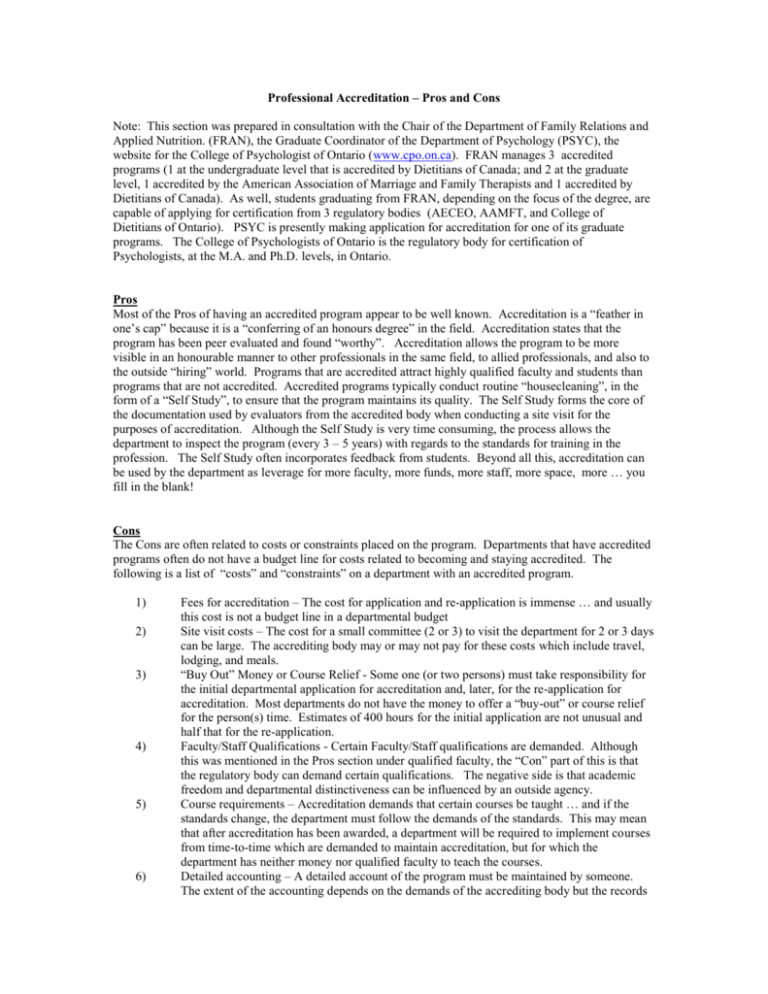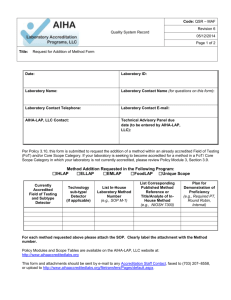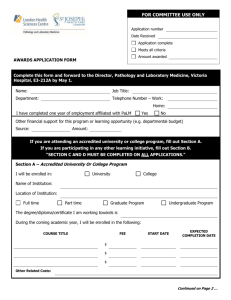Professional Accreditation – Pros and Cons
advertisement

Professional Accreditation – Pros and Cons Note: This section was prepared in consultation with the Chair of the Department of Family Relations and Applied Nutrition. (FRAN), the Graduate Coordinator of the Department of Psychology (PSYC), the website for the College of Psychologist of Ontario (www.cpo.on.ca). FRAN manages 3 accredited programs (1 at the undergraduate level that is accredited by Dietitians of Canada; and 2 at the graduate level, 1 accredited by the American Association of Marriage and Family Therapists and 1 accredited by Dietitians of Canada). As well, students graduating from FRAN, depending on the focus of the degree, are capable of applying for certification from 3 regulatory bodies (AECEO, AAMFT, and College of Dietitians of Ontario). PSYC is presently making application for accreditation for one of its graduate programs. The College of Psychologists of Ontario is the regulatory body for certification of Psychologists, at the M.A. and Ph.D. levels, in Ontario. Pros Most of the Pros of having an accredited program appear to be well known. Accreditation is a “feather in one’s cap” because it is a “conferring of an honours degree” in the field. Accreditation states that the program has been peer evaluated and found “worthy”. Accreditation allows the program to be more visible in an honourable manner to other professionals in the same field, to allied professionals, and also to the outside “hiring” world. Programs that are accredited attract highly qualified faculty and students than programs that are not accredited. Accredited programs typically conduct routine “housecleaning”, in the form of a “Self Study”, to ensure that the program maintains its quality. The Self Study forms the core of the documentation used by evaluators from the accredited body when conducting a site visit for the purposes of accreditation. Although the Self Study is very time consuming, the process allows the department to inspect the program (every 3 – 5 years) with regards to the standards for training in the profession. The Self Study often incorporates feedback from students. Beyond all this, accreditation can be used by the department as leverage for more faculty, more funds, more staff, more space, more … you fill in the blank! Cons The Cons are often related to costs or constraints placed on the program. Departments that have accredited programs often do not have a budget line for costs related to becoming and staying accredited. The following is a list of “costs” and “constraints” on a department with an accredited program. 1) 2) 3) 4) 5) 6) Fees for accreditation – The cost for application and re-application is immense … and usually this cost is not a budget line in a departmental budget Site visit costs – The cost for a small committee (2 or 3) to visit the department for 2 or 3 days can be large. The accrediting body may or may not pay for these costs which include travel, lodging, and meals. “Buy Out” Money or Course Relief - Some one (or two persons) must take responsibility for the initial departmental application for accreditation and, later, for the re-application for accreditation. Most departments do not have the money to offer a “buy-out” or course relief for the person(s) time. Estimates of 400 hours for the initial application are not unusual and half that for the re-application. Faculty/Staff Qualifications - Certain Faculty/Staff qualifications are demanded. Although this was mentioned in the Pros section under qualified faculty, the “Con” part of this is that the regulatory body can demand certain qualifications. The negative side is that academic freedom and departmental distinctiveness can be influenced by an outside agency. Course requirements – Accreditation demands that certain courses be taught … and if the standards change, the department must follow the demands of the standards. This may mean that after accreditation has been awarded, a department will be required to implement courses from time-to-time which are demanded to maintain accreditation, but for which the department has neither money nor qualified faculty to teach the courses. Detailed accounting – A detailed account of the program must be maintained by someone. The extent of the accounting depends on the demands of the accrediting body but the records 7) 8) 9) could include various stats on faculty, supervisory staff , supervised student hours, practicum and field placement sites, number of children and adolescents to whom care was provided in supervised placements, … the list goes on and on and often new computing programs need to be purchased and staff trained to use the programs ( … which, depending on the number of people using the program, can be a reiterative process of training and reprimanding!) Flexibilty – Unless the accreditation process includes several types of programs (children & adolescents, family, clinical, community, etc.) , the accredited program can loose its distinctiveness. A program could have the potential to feel that it is like all other programs that are accredited. Potential for creation of animosity within the department - If the accredited program is a subprogram of a larger department, faculty could begin to see the faculty in the accredited program as the “have’s” and the faculty outside the accredited program as the “have not’s” because so much departmental time, attention and money (not budgeted for …) is expended on the accredited program. Meetings …. Numerous meetings.







